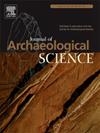Biodiversity science of ancient fisheries: Archaeological indicators of eelgrass meadow health and indigenous (Wiyot) aquaculture, Humboldt Bay, CA
IF 2.5
1区 地球科学
Q1 ANTHROPOLOGY
引用次数: 0
Abstract
Humboldt Bay, California, mirrors many coastal estuaries impacted by historical development and climate change, leading to biodiversity loss. Disintegrating habitats also affect local Indigenous communities, whose deep-rooted histories include stewardship of these biologically and culturally essential places. Understanding human-fisheries dynamics is crucial for biocultural restoration. We present a snapshot of fisheries use at Digawututklh (CA-HUM-23), a Late Holocene ethnographic Wiyot village on the north spit of Wigi (Humboldt Bay), an area experiencing the highest rate of level rise in California that it is exacerbated by the high rate of subsidence where the Juan de Fuca Plate dives under the North American Plate. To expand knowledge of species use, we employ complementary faunal and genetic analyses and test the capabilities of ancient DNA (aDNA) barcoding methods. We employ a broad-spectrum sampling approach to identify previously unidentifiable elements and confirm aDNA identification of fish bone is feasible on a wide range of non-vertebral elements and tiny, fragile fragments. Our findings highlight the potential of this methodology and the need for further sequencing of modern fish bones to refine aDNA species identification. This biodiversity-centered approach provides a more comprehensive picture of historical fisheries in this endangered northern California estuary. Contrary to a salmon-focal economy assumed in prominent developmental models, results reveal complex interactions with multiple fish species, employing diverse capture methods and technologies, such as tidal weirs, nets, and spears. Identified fish species, along with shellfish, crab, waterfowl, and mammals recovered at the site, indicate significant record of human connectivity with eelgrass (Zostera marina) meadows. The eelgrass biome of Humboldt Bay —a highly productive habitat that supplies nutrients, shelter, and nursery grounds for diverse species—was a key target for early indigenous aquaculture, practiced by the some of the earliest sedentary plank house villagers in coastal northwest California. The study provides insight into Wiyot sustainable practices, informed by traditional ecological knowledge of food webs and seasonal spawning and migratory patterns.

古代渔业的生物多样性科学:大叶草草甸健康和土著(Wiyot)水产养殖的考古指标,洪堡湾,CA
加州洪堡湾(Humboldt Bay)反映了许多受历史发展和气候变化影响的沿海河口,导致生物多样性丧失。栖息地的瓦解也影响到当地土著社区,他们根深蒂固的历史包括对这些生物和文化上至关重要的地方的管理。了解人类-渔业动态对生物养殖恢复至关重要。我们在Digawututklh (ca - ham -23)展示了渔业使用的快照,Digawututklh是一个全新世晚期的维尤特人村庄,位于威吉(洪堡湾)的北角,该地区经历了加利福尼亚最高的海平面上升速度,并且由于胡安·德·富卡板块潜入北美板块的高沉降率而加剧。为了扩大物种利用的知识,我们采用了互补的动物群和遗传分析,并测试了古代DNA (aDNA)条形码方法的能力。我们采用广谱采样方法来鉴定以前无法识别的元素,并确认鱼骨的aDNA鉴定在广泛的非椎体元素和微小的易碎碎片上是可行的。我们的发现突出了这种方法的潜力,以及对现代鱼骨进行进一步测序以完善dna物种鉴定的必要性。这种以生物多样性为中心的方法为这个濒临灭绝的北加州河口的历史渔业提供了更全面的画面。与著名的发展模型中假设的以鲑鱼为中心的经济相反,研究结果揭示了与多种鱼类之间复杂的相互作用,采用了多种捕获方法和技术,如潮汐堰、渔网和长矛。在该遗址发现的鱼类、贝类、螃蟹、水禽和哺乳动物表明,人类与大叶藻(Zostera marina)草甸有重要的联系记录。洪堡湾的大叶藻生物群落是一个高产的栖息地,为各种物种提供营养、庇护和苗圃,是早期本土水产养殖的关键目标,最早定居在加利福尼亚西北部沿海的木板屋村民进行了这种养殖。这项研究提供了对Wiyot可持续实践的深入了解,这些实践是由食物网和季节性产卵和迁徙模式的传统生态知识提供的。
本文章由计算机程序翻译,如有差异,请以英文原文为准。
求助全文
约1分钟内获得全文
求助全文
来源期刊

Journal of Archaeological Science
地学-地球科学综合
CiteScore
6.10
自引率
7.10%
发文量
112
审稿时长
49 days
期刊介绍:
The Journal of Archaeological Science is aimed at archaeologists and scientists with particular interests in advancing the development and application of scientific techniques and methodologies to all areas of archaeology. This established monthly journal publishes focus articles, original research papers and major review articles, of wide archaeological significance. The journal provides an international forum for archaeologists and scientists from widely different scientific backgrounds who share a common interest in developing and applying scientific methods to inform major debates through improving the quality and reliability of scientific information derived from archaeological research.
 求助内容:
求助内容: 应助结果提醒方式:
应助结果提醒方式:


